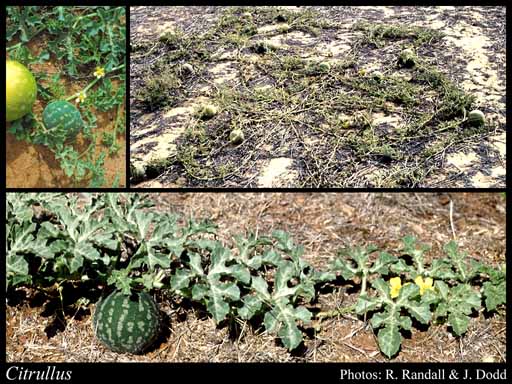- Reference
- Enum.Pl.Afric.Austral. 279 (1836)
- Name Status
- Current

Scientific Description
Common name. Melon. Family Cucurbitaceae.
Habit and leaf form. Herbs, or herbaceous climbers (or trailing). Annual, or perennial. Leaves cauline (ass.). Plants with neither basal nor terminal concentrations of leaves. Stem internodes solid (ass.). Climbing (or trailing); tendril climbers (simple, 2-branched or 4-branched, coiled distally or above point of branching). Tendrils simple, or branched. Mesophytic to xerophytic. Leaves alternate; spiral; petiolate; non-sheathing; simple. Leaf blades dissected; ovate; pinnatifid, or palmately lobed (usually deeply palmately to pinnately lobed, 3–5 ovate lobes); palmately veined; cross-venulate; cordate. Leaves without stipules (tendrils stipular in position, arising from sides of stem near petiole); without a persistent basal meristem. Leaf anatomy. Hairs present. Extra-floral nectaries absent (ass.).
Reproductive type, pollination. Fertile flowers functionally male, or functionally female. Unisexual flowers present. Plants monoecious. Female flowers solitary; with staminodes (3 staminodes). Male flowers solitary. Entomophilous.
Inflorescence and flower features. Flowers solitary (both male and female flowers); axillary; pedicellate (slender); bracteate (at base of peduncle; probracts present); ebracteolate; small to large; regular; cyclic. Free hypanthium present; campanulate (in male flowers), or urceolate (in female flowers, in the lower part narrowed into a short neck then expanded into a campanulate upper part); adnate to ovary. Perianth with distinct calyx and corolla; 10; 2 -whorled; isomerous. Calyx present; 5; 1 -whorled; gamosepalous; blunt-lobed; imbricate, or open in bud; regular. Calyx lobes narrowly ovate to triangular. Corolla present; 5; 1 -whorled; gamopetalous; more or less valvate; regular; green, or white, or yellow, or orange. Corolla lobes ovate (or rotate). Corolla members entire. Fertile stamens present, or absent. Androecial members definite in number. Androecium 3. Androecial members branched and unbranched, or unbranched; adnate (to the hypanthium); all equal (ass.); free of one another (ass.); 1 -whorled. Androecium exclusively of fertile stamens. Stamens 3; distinctly dissimilar in shape (unilocular/bilocular); reduced in number relative to the adjacent perianth; oppositisepalous (towards base of hypanthium, or on floral tube, or on calyx tube below petals). Anthers cohering, or connivent, or separate from one another; adnate; dehiscing via longitudinal slits; extrorse; unilocular (1 anther), or bilocular (2 anthers); bisporangiate, or bisporangiate and tetrasporangiate, or tetrasporangiate; appendaged (via the prolonged connective), or unappendaged. Fertile gynoecium present, or absent. Gynoecium 1 carpelled, or 2–5 carpelled. The pistil 1–3 celled. Gynoecium syncarpous; of one carpel, or synovarious, or synstylovarious, or eu-syncarpous; inferior. Ovary unilocular, or plurilocular; 1–3 locular. Gynoecium stylate. Styles 1; partially joined; apical. Stigmas 3; commissural; 2 - lobed, or 3 - lobed. Placentation parietal; when the ovary plurilocular, axile. Ovules in the single cavity 20–50; 20–50 per locule (many); pendulous, or horizontal, or ascending; non-arillate; anatropous.
Fruit and seed features. Fruit 5–15 cm in diameter; fleshy; not spinose; indehiscent; a berry (a pepo); 20–100 seeded (many). Seeds non-endospermic; medium sized to large; winged, or wingless. Cotyledons 2 (large, flat). Embryo straight.
Etymology. From the Greek for "citron tree" and the diminutive suffix -ull-; indicating smallness.
Taxonomic Literature
- Grieve, B. J.; Blackall, W. E. 1998. How to know Western Australian wildflowers : a key to the flora of the extratropical regions of Western Australia. Part II, Dicotyledons (Amaranthaceae to Lythraceae). University of W.A. Press.. Nedlands, W.A..
- Wheeler, J. R.; Rye, B. L.; Koch, B. L.; Wilson, A. J. G.; Western Australian Herbarium 1992. Flora of the Kimberley region. Western Australian Herbarium.. Como, W.A..